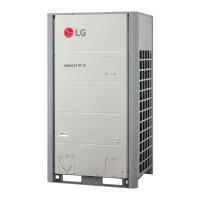Do you have a question about the LG multi V ARUN100BSS0 and is the answer not in the manual?
Critical safety guidelines and warnings related to the installation process.
Safety measures to follow during the operation of the air conditioner.
Important cautions regarding environmental factors, product usage, and maintenance.
Space guidelines for stand-alone/collective installations considering obstacles.
Specifications for anchor bolt location and foundation requirements for unit stability.
Steps for preparing the unit and drawing out pipes from various locations.
Procedures for removing leakage prevention caps and ensuring leak-free connections.
Explanation of Y branch and Header methods for multi-unit refrigerant distribution.
Tables detailing required pipe diameters based on unit capacity and system configuration.
Installation guidelines for Y branches and headers, including insulation and capping.
Steps for performing a nitrogen leak test and applying temperature correction factors.
Method for evacuating the system to remove moisture and air using a vacuum pump.
Essential safety rules, grounding, and general wiring practices.
Guidelines for routing, spacing, and separating power and communication cables.
Selecting appropriate power supply, wiring size, and protection for unit operation.
Illustrates common field wiring, transmission wire connections, and unit wiring examples.
Steps for installing IO modules and checking/setting outdoor unit parameters.
Procedures for automatic addressing, group number setting, and configuring operational functions.
Setting modes for Cool/Heat selection, night low noise, and defrost operations.
Adjusting target pressures and interpreting self-diagnosis error codes for troubleshooting.
Guidelines for calculating limiting refrigerant concentration and minimum room capacity.
Actions to take when concentration exceeds limits, including ventilation and alarms.
Choosing suitable locations and installing windbreaks to protect against sea wind corrosion.
| Refrigerant | R410A |
|---|---|
| Dimensions (Indoor Unit) | Varies by indoor unit type. Refer to specific indoor unit model. |
| Weight (Indoor Unit) | Varies by indoor unit type. Refer to specific indoor unit model. |
| Dimensions (Outdoor Unit) | 950 x 1, 380 x 330 mm |
| Operating Temperature (Cooling) | -5°C to 48°C |
| Power Supply | 380-415V, 3N~, 50Hz |
| Operating Temperature (Heating) | -20 ~ 18 °C |












